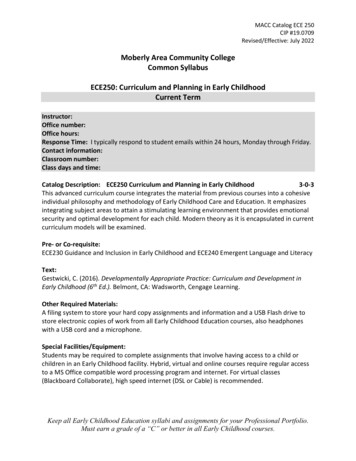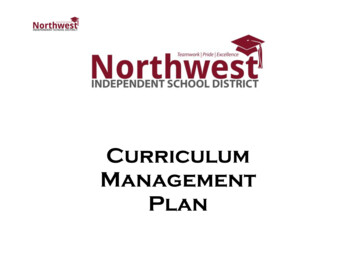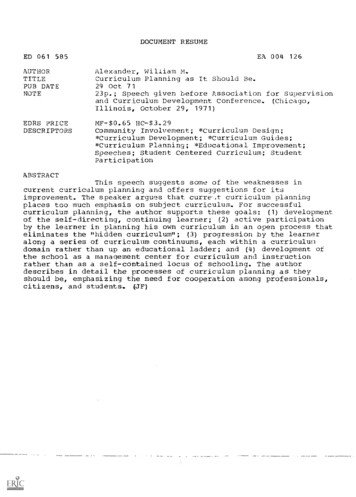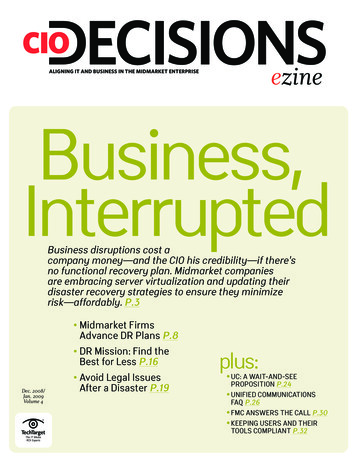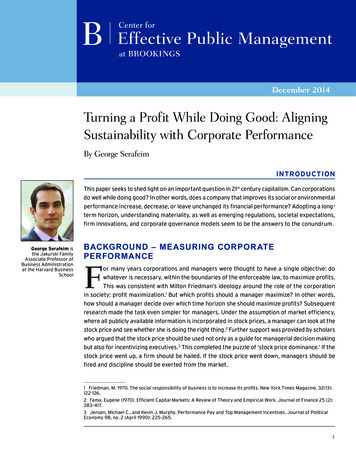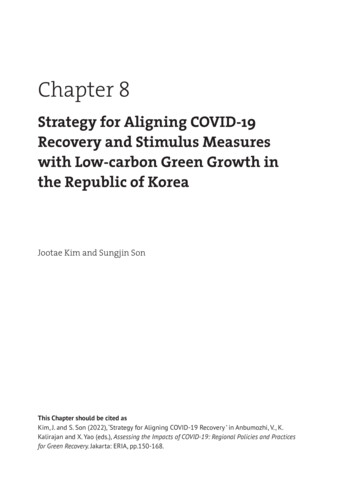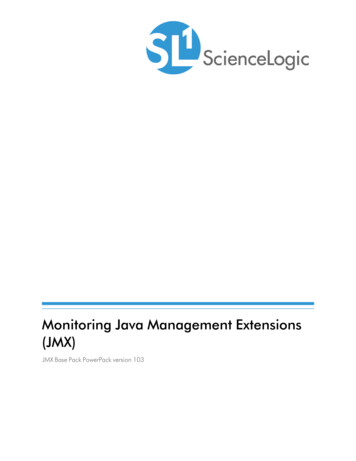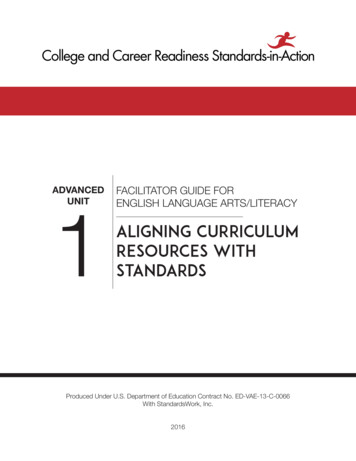
Transcription
ADVANCEDUNIT1FACILITATOR GUIDE FORENGLISH LANGUAGE ARTS/LITERACYAligning CurriculumResources WithStandardsProduced Under U.S. Department of Education Contract No. ED-VAE-13-C-0066With StandardsWork, Inc.2016
This page intentionally left blank.
Table of ContentsBackground and Purpose.1Overview.4Workshop Materials .5Time Frame.5Preparations.6Implementation Directions . 8 Part 1—Evaluate the Alignment of an Adult EducationCurriculum Resource with CCR Standards.8Part 2—Fill Alignment Gaps in the Curriculum Resource.17Part 3—Complete the Curriculum Resource for Instructional Use.20
This page intentionally left blank.
Background and PurposeStates around the nation are integrating college and career readiness (CCR) demands intotheir adult education programming. Raising the academic bar reflects a willingness onthe part of states to act on the empirical evidence of what colleges and employers requireof prospective students and employees.The U.S. Department of Education’s Office of Career, Technical, and Adult Education(OCTAE) has been supporting states’ efforts, for over a decade, through its program ofnational leadership activities. A technical assistance report was produced for states tovoluntarily employ when strengthening their academic programs.1 OCTAE then initiatedthe Implementing CCR Standards in Adult Education project, more commonly known asCCR Standards-in-Action (CCR SIA). Since 2014, the CCR SIA project has developedseveral professional development units.The CCR SIA project initially developed four foundational professional development unitsto ensure that instructors clearly understand the intent and meaning of CCR standards. Attheir heart is a focus on the most critical content and processes for developing the kind ofmathematics mastery needed for college and careers. Through Foundational Units 1–4,adult educators learn how important it is to concentrate mathematics instruction on threekey instructional advances: Selecting texts of sufficient complexity; Developing the ability to draw evidence from texts; and Making the connection between text comprehension and knowledge acquisition.States that are deeply involved in implementing CCR standards report that the trainingembedded in Foundational Units 1–4 has been an essential first step in helping adulteducators become comfortable with the instructional, curricular, and leadership demandsof the three key advances.Once instructors clearly understand the intent and meaning of CCR standards, the next step isto work through how, over time, they will support students in meeting them. This work is atthe heart of Advanced Unit 1. It builds on and extends the content of the foundational units.The CCR Standards for Adult Education report is available dsAdultEd.pdf. (2013)11College and Career Readiness Standards-in-Action Aligning Curriculum Resources With Standards ELA/Literacy
Advanced Unit 1 increases the level of engagement with the key instructional advancesin the areas of application, experimentation, advocacy, and innovation. The trainingembedded in Advanced Unit 1 not only deepens adult educators’ understanding of the intentand meaning of the standards; it introduces teacher-friendly tools to facilitate effectivestandards-based instruction. Advanced Unit 1 materials and methods: Delve into the instructional and institutional implications of level-specific CCRstandards; and Help shape the approach adult educators will take in teaching the standards andin sustainably implementing standards-based reforms.Curriculum resources—often purchased by a program—play a central role in how mostinstructors organize content and set learning tasks. Research shows that resources liketextbooks and workbooks greatly influence how teachers make the leap from intentionsand plans to tangible classroom activities.2 In recognition of our reliance on curriculumresources as guides for instruction, Advanced Unit 1 focuses on how to analyze and thenadapt curricula to align with CCR standards. The specific objectives of this unit are twofold: To teach adult educators how to analyze the degree of alignment between adulteducation curriculum resources and the expectations of CCR standards; and To teach adult educators how to modify curriculum resources so that they tightlyalign with these standards.Checking for alignment ensures that instructors willprovide instruction centered on what CCR standardsdemand—not simply on what the current curriculumfocuses. Learning how to evaluate curriculum resourcesbuilds instructors’ capacity to align their teachingwith the standards. It also provides instructors withopportunities to work together to define what CCRstandards-based instruction should look like.Checking for alignmentensures that instructorswill not simply teach whatthe current curriculumfocuses on, but ratherprovide instructioncentered on what thenew standards demand.2Association for Supervision and Curriculum Development. (1997). Education Update, Vol. 39, No. 1.; Schmidt, W.H., McKnight, C. C., & Raizen, S. A. (1997). A Splintered Vision: An Investigation of U.S. Science and MathematicsEducation. Boston/Dordrecht/London: Kluwer Academic Publishers.2College and Career Readiness Standards-in-Action Aligning Curriculum Resources With Standards ELA/Literacy
Achieving both objectives of Advanced Unit 1 requires an understanding of both thestandards and the curriculum. Research shows that instructors who know what standardsthey are adopting are the individuals best positioned to evaluate and rewrite curriculumresources currently in use.3 Immediately addressing the gaps they identify in the analysisof curriculum resources increases the buy-in that is so vital for effective curriculum reform.The process of identifying and filling gaps in curricula also provides instructors with readilyavailable resources aligned with the standards.By taking these actions, instructors will increase their understanding and ownership of thestandards. They will also gain the skills needed to align curriculum resources and put theresources to use in implementing instruction that fully addresses the standards. Records ofthese evaluations and subsequent revisions will also serve as valuable resources for staffwho were not involved in the original evaluation and revision processes.Share the results across programs! Sharing provides a practical way to disseminateimportant information about the demands of the standards and how well certain curriculumresources align with them.3Judy A. Johnson, EdD. Principles of Effective Change: Curriculum Revision That Works.3College and Career Readiness Standards-in-Action Aligning Curriculum Resources With Standards ELA/Literacy
OverviewThe method outlined below will empower adult educators in your state toanswer two crucial questions: Are the curriculum resources we are using tightly aligned with CCR standards? How can we modify curriculum resources currently in use to more tightly alignwith CCR standards?PART 1 of the advanced unit begins with teaching adult educators how to discern whatcurriculum resources aligned with CCR standards look like. First, they will review thealignment and utility of a sample set of lessons from an adult education curriculum resourceyou choose using the ELA/Literacy Resource Alignment Tool. That tool is organizedaround the key advances and level-specific demands of the CCR standardsPART 2 of the advanced unit teaches adult educators how to begin to fill alignment gaps inthe curriculum resource by selecting one lesson to improve, using the ELA/Literacy LessonRevision Template. The result will be a lesson thatexemplifies both the key advances and level-specificA distinguishing featuredemands of the standards and can be seamlesslyof the advanced (over theintegrated into instructors’ existing curriculum.foundational) units is thatthe work extends wellPART 3 of the advanced unit focuses on organizingbeyond the initial two-dayproduction teams who can continue the work subsequenttraining.to PART 1 and PART 2 training. A distinguishingfeature of the advanced (over the foundational) units isthat the work extends well beyond the initial two-day training. Teams, made up of trainedadult educators, will be asked to revise additional lessons in the curriculum resource overseveral months. You will want to set expectations for how many lessons in the curriculumresource(s) will be modified, over what period of time, and how the work will get done(e.g., in person or virtually, in small or larger teams, using different levels of review).4College and Career Readiness Standards-in-Action Aligning Curriculum Resources With Standards ELA/Literacy
workshop Materials Resource Alignment Tool for English Language Arts/LiteracyLesson Revision Template for English Language Arts/LiteracySupport documents Quantitative and Qualitative Text Complexity Resources Checklist for Evaluating Question Quality Promoting Volume of Reading to Build Knowledge PowerPoint slide presentationReference copies of the state’s CCR standards for English languagearts/literacy (one per table)Curriculum resource of your choice to review Time FrameThe initial process of evaluating a curriculum resource for its alignmentwith CCR standards (Part 1) will take a team 5 to 7 hours.The time needed to revise one lesson (Part 2) in the curriculum resourcewill vary depending on how much modification is required to bring it intoalignment. The initial training to modify a lesson could take 6 to 8 hours.Once reviewers have been trained and are familiar with the process, adult educators shouldbe able to revise subsequent lessons in the curriculum resource (Part 3) in less time,about 2 to 3 hours.5College and Career Readiness Standards-in-Action Aligning Curriculum Resources With Standards ELA/Literacy
PreparationsDetermine which curriculum resource will be analyzed. Organizeeach training session by common curriculum resource and level of learning.This way, all participants in the room can share their findings and insights. Ifyou are able to choose a curriculum resource that most people are currentlyusing, ask them to bring copies to the training session.Get acquainted with the curriculum resource that training participants willevaluate. Doing so will provide you with insight into the content and sequencing of thelessons so you can select a representative sample for participants to evaluate. Ways tounderstand how a curriculum resource is organized and to gain a sense of its content include: Examining the table of contents; Looking through the introduction, glossary, index, appendices, and anyaccompanying digital curriculum resources; and Scanning assessments (e.g., pre-, post-, self-, summative, formative) forinformation about the goals and expectations of the lessons.Select a representative sample of the lessons from the curriculum resourcefor participants to inspect. Select between 10% and 20% of the lessons in thecurriculum resource. Because materials in a curriculum resource commonly are writtenby the same author(s), participants can gain a sense of its strengths and weaknesses byreviewing a representative sample. (Note: A curriculum resource from the same publisher,but written for another level of learning will need to be evaluated separately. The findingsfrom one level of learning cannot be extrapolated to another level of learning.)Familiarize yourself with the PowerPoint presentation and participantmaterials (tools and templates, support documents). Detailed notes in thePowerPoint presentation will help you prepare for the training. Notes for each slide include theidentification of the Big Idea and Facilitator Talking Points, and Facilitator Notes. These willhelp you frame your presentation and provide important context. The slides, coupled with theinformation in this Facilitator Guide, should give you the support and guidance necessary tolead a successful training. Consider rehearsing before the training so you master the material.With practice, you will be able to put ideas in your own words rather than read the slides wordfor word, as well as answer questions from training participants as they come up.6College and Career Readiness Standards-in-Action Aligning Curriculum Resources With Standards ELA/Literacy
Prepare the training materials. If possible, provide digital copies of the materials toparticipants before the training (on USB flash drives or through email). Then staff memberscan evaluate and align curriculum resources electronically—an efficient way for them tocomplete the work. If materials cannot be made available electronically, make copies of thematerials listed on page 4.Create small groups of participants, ideally four to eight at each table. Themaximum size of a group for this training depends on your space, need, and comfort level.Make the group small enough so that you can be in touch with each table of participants.This way you can make sure participants understand the concepts and are fully engaged.Select table leaders in advance, or ask each table to choose a leader. Tableleaders should keep track of time and make sure activities are moving along. Table leaderscan also share information with the table and notify you when there are questions or ifthe group needs more support. (If you choose table leaders in advance, provide them withcopies of the PowerPoint presentation, agenda, and all participant materials, including thetools and templates and the support documents.)7College and Career Readiness Standards-in-Action Aligning Curriculum Resources With Standards ELA/Literacy
Implementation DirectionsPart 1—Evaluate the Alignment of an Adult EducationCurriculum Resource With CCR StandardsIntroduce the purpose of Part 1 and review the evaluation process (Slide 3).Explain that the process performed in Part 1 helps determine the degree of alignment ofexisting curriculum resources with the CCR standards. Organized by the key instructionaladvances of the CCR standards, the ELA/Literacy Resource Alignment Tool is a guideto highlight a curriculum resource’s strengths and gaps in alignment. The tool prioritizesactions needed to modify the curriculum resource to achieve closer alignment with thestandards. The tool, once filled in, also provides documentation for other instructors tofollow when determining whether and how the curriculum resource will benefit them.Introduce the ELA/Literacy Resource Alignment Tool (Slides 4-5). Go over thetool with participants. The criteria in the ELA/Literacy Resource Alignment Tool reflect themost significant advances in instruction that the CCR standards require. They detail what itmeans for curriculum resources to be aligned with those criteria. Review the directions aswell as the three key evaluation criteria:CriterionText Complexity: Does the curriculum resource provide regularpractice with complex text and its academic language?Rationale: Providing students with access to more complex texts willprepare them for the rigors of college- and career-level reading.CriterionEvidence: Does the curriculum resource provide reading, writing,and speaking activities grounded in evidence from text, both literary and informational?Rationale: Providing students with ways to examine a text through goodquestions gives students the crucial support they need to comprehend theideas expressed in complex texts. Asking students to collect evidence whilethey read also contributes to their ability to learn from what they are reading.CriterionKnowledge: Does the curriculum resource build knowledge throughcontent-rich nonfiction?Rationale: Well-crafted culminating writing assignments tied to contentrich texts can help students collect and expand their knowledge. And askingstudents to read a coherent selection of texts allows them to grow theirknowledge and vocabulary.8College and Career Readiness Standards-in-Action Aligning Curriculum Resources With Standards ELA/Literacy
Scan the contents of the sample curriculum resource (Slide 6). Once you haveintroduced the ELA/Literacy Resource Alignment Tool, give participants at least 15 minutesto get acquainted with the sample curriculum resource they will be evaluating. The table ofcontents is a good place to start. It will tell participants what pieces of content are includedand how the curriculum resource is organized. Curriculum resources often address multiplelevels. As a group, determine the predominant level that the curriculum resource addresses;lessons within the curriculum resource will be evaluated against that level.After reviewing the table of contents, ask participants to skim the rest of the curriculumresource: Are there discrete lessons, assessments, student activities, vocabulary words, andteacher notes? This way participants will know where to look for certain information asthey evaluate the alignment of lessons within the curriculum resource with each criterion.9College and Career Readiness Standards-in-Action Aligning Curriculum Resources With Standards ELA/Literacy
Address CriterionText Complexity:Take the following steps to show participants how to evaluate the alignment of thecurriculum resource to this criterion. (While the criteria and dimensions differ in substance,the evaluation steps are the same from criterion to criterion.)Provide a brief presentation on Dimension 1.1 from the Resource AlignmentTool: Text Complexity and Quality (Slides 7-9). Provide a rationale and theimpact this dimension should have on what participants find in the curriculumresource. Because success in most work and college settings requires the ability toread and comprehend complex textsindependently, explain that the first dimensionBecause success in mostfocuses on the quality of text. Point out thatwork and college settingsresearch shows that reading high-quality text—requires the ability to readcontent-rich text that is worth reading—increasesand comprehend complexreading proficiency3. Therefore, your participantstexts independently,should expect that most of the texts in theexplain that the firstcurriculum resource are at the appropriate leveldimension focuses on theof complexity and quality, as defined by the CCRquality of text.standards.Introduce the support materials that can be used to assist with the evaluationprocess (Slide 10). If the publisher has included quantitative measures, instructparticipants to check the Quantitative Analysis Chart for Determining TextComplexity to see if the measures fall within the appropriate band for the level. Ifthe publisher has not included any quantitative measures, ask participants to followthe directions for how to run a passage or two from the curriculum resource throughone of the computer programs mentioned in the quantitative analysis chart.Review the guiding questions related to Dimension 1.1. Then ask participants towork at their tables to look for evidence in the curriculum resource to supportthe answers (Slide 11). Walk participants through the questions for this dimension.Ask them to read the passages accompanying the lessons and determine together ifthey are content-rich and/or exhibit exceptional craft and thought—making themworth reading and learning from.ACT, Inc. (2006). Reading between the lines: What the ACT reveals about college readiness in reading.Iowa City, IA: Author.310College and Career Readiness Standards-in-Action Aligning Curriculum Resources With Standards ELA/Literacy
Ask participants to complete the evaluation of Dimension 1.1 with others attheir table (Slide 12). Give participants at least 15 minutes to review the selectedlessons in the curriculum resource. They need to record the strengths and weaknessesof the curriculum resource and rate the dimension as: Meets: There is evidence in the resource to indicate that this dimension is met;Partially Meets: There is evidence in the resource to indicate that the dimensioncan be met with some revision; orDoes Not Meet: There is little or no evidence in the resource to indicate that thedimension is being met. Substantial revision is needed for alignment.Provide a brief presentation on Dimension 1.2 from the Resource Alignment Tool:Academic Vocabulary (Slides 13-15). Provide a rationale and the impact this dimensionshould have on what participants find in the curriculum resource.Explain that this second dimension explores theimportant role that academic vocabulary (TierExplain that this second2) words play in understanding complex text. Indimension exploresyour presentation, point out that research showsthe important role thatthat vocabulary is central in reading andacademic vocabularylistening comprehension4.Therefore,(Tier 2) words play inparticipants should expect that most lessons inunderstanding complex text.the curriculum resource regularly focus onasking students if they understand words andphrases (particularly general academic words and phrases) as well as the relationshipsand nuances of the vocabulary.4Whipple, G. (Ed.) (1925). The Twenty-fourth Yearbook of the National Society for the Study of Education: Reportof the National Committee on Reading. Bloomington, IL: Public School Publishing Company; Baumann, J. F., &Kameenui, E. J. (1991). Research on vocabulary instruction: Ode to Voltaire. In J. Flood, J. M. Jensen, D. Lapp, & J. R.Squire (Eds.), Handbook of research on teaching the English language arts (pp. 604–632). New York, NY: Macmillan.Baumann & Kameenui, 1991; and Becker, W. C. (1977). Teaching reading and language to the disadvantaged—Whatwe have learned from field research. Harvard Educational Review, 47, 518–543.11College and Career Readiness Standards-in-Action Aligning Curriculum Resources With Standards ELA/Literacy
Review the guiding questions related to Dimension 1.2. Then ask participantsto work at their tables to look for evidence in the curriculum resource tosupport the answers (Slide 16). Ask participants to determine whether academicvocabulary words, central to understanding the text in a lesson, have been identifiedfor teachers to focus on with their students. (Academic vocabulary consists ofwords—such as “relative,” “formulate,” “dedicate,” and “structure”—that appearoften in academic, technical, and literary texts. They are not used as commonly ininformal speech but are critical for successful college- and career-level reading.)Ask participants to complete the evaluation of Dimension 1.2 with others attheir table (Slide 17). Give participants at least 15 minutes to work so they canboth record the strengths and weaknesses of the curriculum resource and rate thedimension.Conduct a group debrief of Criterion 1 (Slide 18). Get a sense of what participantsthink about the quality and complexity of texts in the curriculum resource. Checkon their findings about the curriculum resource’s focus on academic vocabularytoo. Learn the level of group consensus and find out which questions instructorsstill have about the role of text complexity and quality in a curriculum resource.Consider what high-value actions (listed in the ELA/Literacy ResourceAlignment Tool) need to be taken to improve the alignment of the curriculumresource with Criterion 1 (Slide 19).12College and Career Readiness Standards-in-Action Aligning Curriculum Resources With Standards ELA/Literacy
Address CriterionEvidence:Take the following steps to show participants how to evaluate the alignment of thecurriculum resource to this criterion.Provide a brief presentation on Dimension 2.1 from the Resource AlignmentTool: Growth of Comprehension and Using Evidence From Texts (Slides 20-22).Provide a rationale and the impact this dimension should have on what participantsfind in the curriculum resource. Explain that success in most work and college settingsrequires using evidence to draw accurate and logical conclusions. Asking textdependent questions that require students to provide evidence and make inferencesfrom what they have read helps guide reading andimproves reading comprehension. Therefore, yourparticipants should expect that an overwhelming Asking text-dependentmajority (80%) of all questions about what students questions that requireread in the curriculum resource are high-quality students to provideevidence and maketext-dependent and text-specific questions.inferences from what theyhave read helps guideIntroduce the concept of text-dependentreading and improvesquestions (Slides 23-24). Text-dependentreading comprehension.questions are not low-level literal or recallquestions; they do not target particular readingstrategies or rely on students’ background knowledge. Instead, they focus onanalysis, synthesis, and evaluation to support students’ comprehension of complexmaterial.Introduce the support materials that can be used to assist with the evaluationprocess (Slide 25). Use the Checklist for Evaluating Question Quality to determinewhether the questions connected to the passages are text-specific and standardsbased and whether they require students to produce evidence from the text.Review the guiding questions related to Dimension 2.1. Then ask participantsto work at their tables to look for evidence in the curriculum resource tosupport the answers (Slide 26). Ask participants to look for questions that addressthe text’s central ideas, target the level-specific demands of the standards, and buildunderstanding of the text. These can be speaking or writing tasks that ask studentsto produce evidence from the text in a lesson.13College and Career Readiness Standards-in-Action Aligning Curriculum Resources With Standards ELA/Literacy
Ask participants to complete the evaluation of Dimension 2.1 with others at theirtable (Slide 27). Give participants at least 10 minutes to work so they can both recordthe strengths and weaknesses of the curriculum resource and rate the dimension.Provide a brief presentation on Dimension 2.2 from the Resource AlignmentTool: Emphasis on Informative and Argumentative Writing and Speaking(Slides 28-30). Provide a rationale and the impact this dimension should have onwhat participants find in the curriculum resource. Explain that this second dimensionfocuses on the importance of students’ writing about what they read as another wayto learn in the classroom and to succeed in life. Drawing on evidence from texts topresent careful analyses and well-defended claims should be central in adult education.Therefore, participants should expect that an overwhelming majority (80%) of allwriting and speaking assignments that they review in the curriculum resource requireargumentative and informative writing and speaking.Review the guiding questions related to Dimension 2.2. Then ask participants towork at their tables to look for evidence in the curriculum resource to supportthe answers (slide 31). Ask participants to calculate the percentage of writing andspeaking assignments that require students to provide text-based evidence. Noteany assignments that do not require writing or speaking about the sources theyread. (This process should move faster now that participants are reviewing—andare familiar with—the same representative sample of lessons.)Ask participants to complete the evaluation of Dimension 2.2 with others at theirtable (Slide 32). Give participants at least 15 minutes at their tables so they can bothrecord the strengths and weaknesses of the curriculum resource and rate the dimension.Conduct a group debrief of Criterion 2 (Slide 33). Get a sense of what instructorsthink about the quality of the questions in writing and speaking assignments. Checkon the level of consensus in the group and find out which questions participants stillhave about the role of text-based and text-specific questions in lessons.Consider what high-value actions (listed in the ELA/Literacy ResourceAlignment Tool) need to be taken to improve the alignment of the curriculumresource with Criterion 2 (Slide 34).14College and Career Readiness Standards-in-Action Aligning Curriculum Resources With Standards ELA/Literacy
Address CriterionKnowledge:Take the following steps to show participants how to evaluate the alignment of thecurriculum resource to this criterion.Provide a brief presentation on Dimensions 3.1 and 3.2 from the ResourceAlignment Tool: Emphasis on Reading Content-Rich Text and BuildingKnowledge Through Reading Widely About a Topic and Research (Slides 3537). Provide a rationale and the impact this dimension should have on whatparticipants find in the curriculum resource. Explain that because readingcomprehension is tied to prior knowledge and is a critical component in theclassroom and workplace, the dimensions in thiscriterion prioritize cultivating students’Point out that researchknowledge base through reading and writingshows that studentsabout content-rich material. Point out thatbetter comprehendresearch shows that students better comprehendwhat they read whenwhat they read when they systematically buildthey systematically buildknowledge about a topic5. Therefore, participantsknowledge about a topic.should expect that the curriculum resourceaccentuatescompreh
ADVANCED 1 UNIT FACILITATOR GUIDE FOR ENGLISH LANGUAGE ARTS/LITERACY Aligning Curriculum Resources With Standards Produced Under U.S. Department of Education Contract No. ED-VAE-13-C-0066

